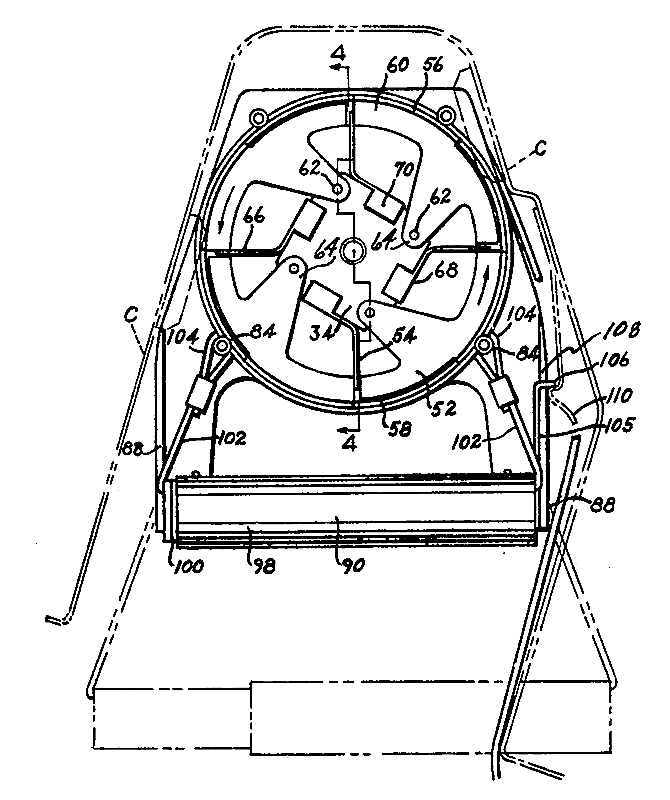Technical Details
 I acquired this Capewell Components 747 Pilot Emergency Decent Device from Danny Duarte in 2025.
I acquired this Capewell Components 747 Pilot Emergency Decent Device from Danny Duarte in 2025.
My Decent Device is 231 mm. tall, 178 mm. wide, 32 mm. thick, and weighs 1509 g.
The Decent Device has a stamped outer casing that encloses a reel of steep tape wound on a storage drum. A telescoping handle is stored at the bottom of the casing. A sharp pull releases the handle, which drops and extends to a size that allows the user to grip the handle with both hands for descent.
The steel tape on the drum is attached to a short steel cable with a loop at the end for fastening to a secure anchor. As the user descends, the reel unwinds, releasing the tape. Pivoting brake shows centrifugally extend to contact a brake drum on the inner reel surface, limiting the maximum rate of descent.
As the ribbon pays off the reel, pivoted brake shoes carried thereby extend centrifugally into contact with a stationary brake drum forming a part of the case and thus limit the maximum rate of descent to a predetermined level for a load of given weight. Provision is made for keeping the tape or ribbon tightly coiled so, that no slack must be taken up prior to the commencement of reel rotation ans the centrifugal braking action that is a function of the latter. Provision is also made for rewinding the payed out tape for reuse.
The front has a label printed with "Aircraft Compatibility," "Descent Device P/N 379103C-17," "Boeing," "747-100 Series," "747-200C Series," "747-200F Series," the Capewell Components logo, "CAPEWELL," and "Life Support/Aerial Delivery Systems." A second label is printed with "DESCENT DEVICE," "PART NO."," 379103C-17," "SERIAL NO.," "1454," "DATE OF MFR.", "N/A" (handwritten), "REBUILT DATE", "DECEMBER 7 2006," "CERTIFICATION EXP.," "DECEMBER 7 2011," "CAPEWELL," "105 Nutmeg Rd. South, South Windsor, CT 06074 USA," "COVERED BY ONE OR MORE OF U.S> PATENTS 3602483, 3738456, DES220534 AND CORRESPONDING FOREIGHN PATENTS ISSUED IN FRANCE AND CERTAIN OTHER COUNTRIES."
The rear has a label printed with"EMERGENCY DESCENT DEVICE," "This unit is designed for One Use Only and must be rebuilt and recertified prior to returning to service.," "To ensure safe operation, this device is required to be returned to Capewell for rebui9ld and recertification if any of the following conditions exists:," "• Device has been used once.," "• Warranty/Certification date has expired.," "• Safety seals have been broken.," "•Physical damage is evident.," "Consult aircraft manufacturer's instructions for installation and inspection procedures.," "After this unit's one use, return to Capewell for rebuild and recertification.," "Capewell Components," ""105 Nutmeg Rd. South, South Windsor, CT 06074 USA," "Phone: (860) 610–0700 Fax: (860) 610–0120."
The Handle has a sticker printed with "379103C– 17," "Emergency Descent Device/Certification Exp. Date : DEC. 7 2011"
Frost Engineering Development Corporation developed the Emergency Decent Device and received U.S. Patent #3,602,483 for it in 1971. The patent lists some novel design requirements. My favorite is the one to avoid requiring any form of harness. Instead, the user must grip a handle with both hands and hold on while they descend. I do not completely understand how disabled passengers, young children, infants, etc. would safely use this device without self-Darwining. Be that as it may, someone in the aviation industry decided that this device was suited for pilots, and adopted it for selected 747-series aircraft. My Capewell unit has a removable harness attachment eye that my Frost unit lacks. The eye encourages violating the “no harness allowed” design requirement.
Another design requirement is to not allow the user to have any control over the descent rate. I am biased, and the idea of having a descender designed to deny me any and all control over my rate of descent does not appeal to me. I can, however, see situations when some people should not be given that control, and I would not assume that all random passengers exiting a burning airliner would act rationally, despite that being in their best interest.
My Capewell unit requires returning their unit to the manufacturer after each use, forcing the user to decide between training, crashing, or buying multiple units. To those who understand aviation regulations, the Capewell approach may make sense.
I do not recommend this device for recreational caving of climbing use. It was designed for a different application, and some of the design requirements and executions are not consistent with our needs
History
I have two of these. The first, made in 1970, was from Frost Engineering Development Corporation of Englewood Colorado. Capewell Components acquired Frost Engineering in 1994. My second unit came from Capewell who reconditioned it in 2006.



